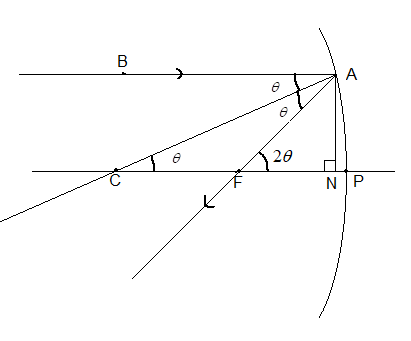Question
Question: Write the relation between focal length and radius of curvature of a spherical mirror....
Write the relation between focal length and radius of curvature of a spherical mirror.
Solution
Hint: Before stating the relation, derive the relation between radius of curvature and the focal length of a mirror. This will help you understand better. Use the fact that when a parallel ray of light falls on a concave mirror, it passes through the focus of the mirror after reflection.
Complete step by step answer:
The relation between focal length (f) and radius of curvature (R) of a spherical mirror is that the focal length is equal to half of the radius of curvature i.e. f=2R.
Let us derive this relation.
Consider a concave mirror such that its radius of curvature is very much larger than the diameter of its aperture.
We can take help from the figure given.

Suppose a parallel ray of light is incident on the mirror as shown in the figure. Let this incident ray make an angle θ with normal to the surface of the mirror. Since this mirror is part of a circle, the normal drawn to the surface of the circle passes through the centre (C) of the mirror.
We know that rays of light parallel to the principal axis passing through the focus (F) of a concave mirror, after reflection.
According to the law of reflections, the angle of incidence and angle of reflection are equal. Therefore, ∠BAC=∠FAC=θ as shown in the given figure.
Since BA and PC are parallel, ∠BAC=∠ACF=θ.
Therefore, from exterior angle theorem ∠AFN=∠ACF+∠CAF=2θ.
Now drop a normal CP from point A. Let the foot of this normal be N.
Here, tanθ=CNAN⇒AN=CNtanθ ……. (i).
tan2θ=FNAN⇒AN=FNtan2θ ….. (ii).
From equation (i) and equation (ii) we get,
CNtanθ=FNtan2θ
⇒FNCN=tanθtan2θ …… (iii).
Since the radius of curvature is very much larger than the diameter of its aperture, NP is very small compared to CN and CP and θ will be a small angle .
Therefore, CN≈CP and FN≈FP.
For small angles tanθ=θ and tan2θ=2θ.
Therefore, equation (iii) can be written as
⇒FPCP=θ2θ⇒FP=2CP
And CP=R and FP=f.
Hence, f=2R
Note: Note that this relation between the radius of curvature (R) of a concave mirror and the focal length (f) of the mirror, which is f=2R, is true only when the R is very much larger than the diameter of its aperture.
